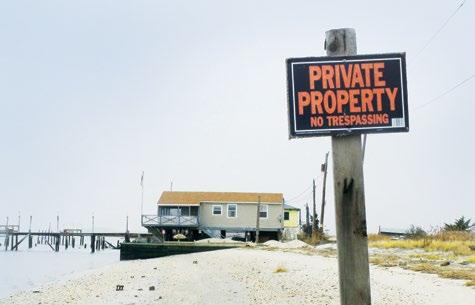
2 minute read
3 REASONS TO CARE ABOUT ACCESS TO THE BAY
By Sari Rothrock, Watershed Planning Specialist II, Partnership for the Delaware Estuary
What does it mean to preserve access to the Delaware Bay? When we talk about access, what are we really talking about? Access is about much more than your right to march down to the bay beaches and wiggle your toes in the water, but we’re talking about that, too. When the Partnership for the Delaware Estuary (PDE) talks about preserving access, we’re talking about three things: building affinity for the Delaware River and Bay, safeguarding a unique sense of place, and sustaining a way of life.
Advertisement
Preserving access is about… building affinity for the Delaware Bay
Ensuring that people have access to the water — allowing people to see, touch, and experience the bay — is critical for building the passion and understanding that drives people to be good stewards of the bay’s resources. Building affinity for the bay can help people to understand the importance of efforts by the PDE and others to make water and habitats cleaner for fish, wildlife, and people. PDE-supported events like Coast Day festivals in Pennsylvania and Delaware and Bay Day in New Jersey foster this connection.
Preserving access is about… safeguarding a unique sense of place
The bayshore is a quiet, unadorned, and naturally beautiful region where the people live alongside acres of preserved tidal wetlands and the flow of the Delaware Bay and its tributaries. Around the Delaware Bay, there remain a handful of small communities that are truly bayfront, like Money Island and Bivalve in New Jersey, and Bayview and Slaughter Beach in Delaware (just to name a few!). Even the names themselves evoke a strong tie to the bay and the livelihoods that depend on it. The marshes and waterways that surround them provide not only peace and quiet, but also some protection from flooding and storms. The PDE is working with communities to protect the wetlands, shellfish and other natural resources that protect and sustain them. On March 3, the PDE and local partners on the New Jersey bayshore will be re-releasing the “Cumberland County Bayshore Recovery Plan,” which will include new strategies for investing in clean water and pollution controls that increase the resilience of communities there. communities means not only losing homes, but also resources like docks and marinas that fishermen, crabbers, and oystermen depend on to make their living.
A principle called the Public Trust Doctrine ensures that the American public has access to, and use of, coastal lands, water, and resources. It is an old doctrine, adopted by the 13 original colonies (including New Jersey, Delaware, and Pennsylvania) and passed on to the states
Preserving access is about… sustaining a way of life
There used to be other bayfront communities; sadly, they have been overcome by storms and flooding, sea level rise and erosion. One such community was Sea Breeze, which, after being badly battered by storms, was bought out by the New Jersey Department of Environmental Protection (NJDEP) in 2010 and 2011. Similarly, Bay Point in Lawrence Township, after an assault from Superstorm Sandy, has been offered a buyout from the NJDEP. Sandy badly damaged other bayshore towns as well — but these communities are rallying to preserve their way of life. Losing these after the American Revolution. However, unless we make concerted efforts to protect points of public access from disuse, sea level rise, and an increasing number and intensity of storms, we’ll lose opportunities to access the Delaware Bay.
Sustaining and enhancing access in bayfront communities and increasing access in underserved urban areas are two goals recently developed and articulated by the PDE and its agency partners in the National Estuary Program. To learn more about these and other goals for healthy waters, healthy communities, and healthy habitats, visit DelawareEstuary .org/Goals. ■




